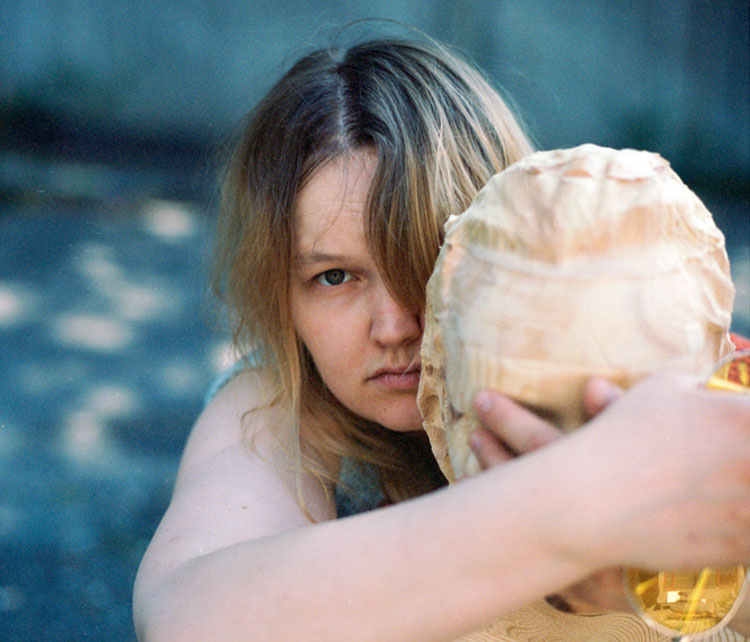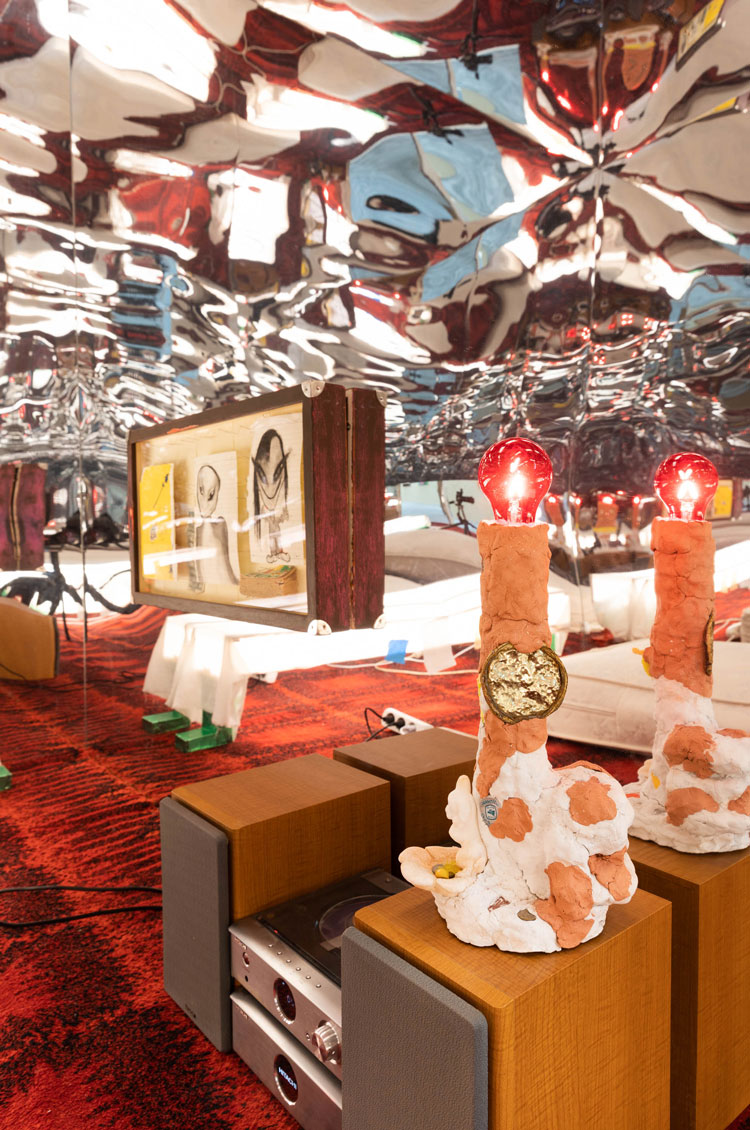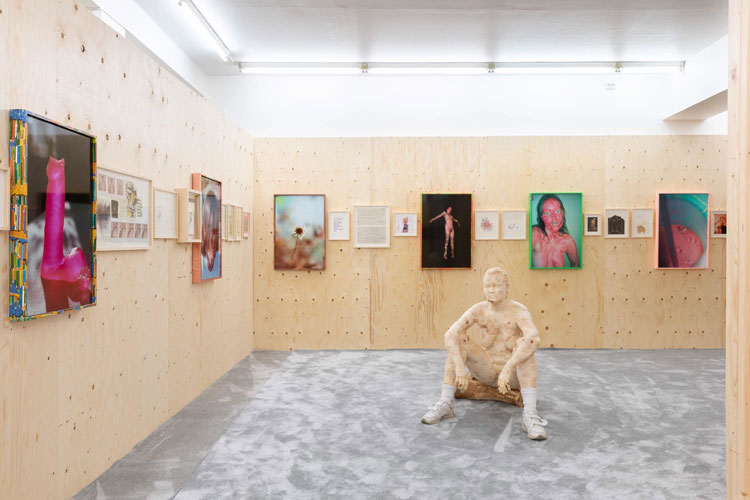
Maria Pasenau. Photo: Ida FIskaa.
by IZABELLA SCOTT
I arrive in Oslo on a grey, overcast day to see Maria Pasenau’s solo show at Fotogalleriet, which was the first Nordic gallery dedicated to photography when it was established in 1977. The windows have been boarded up, leaving a display of wobbly ceramics – a crowd of brown spiky devils – and a punk poem-sculpture, written in silver paint, which reads: “The day i was born i bord in to this boring word, i left all i knowd was forsed, put in to this clinical shit hole.” It sets the tone of the show, one that suggests a departure from Fotogalleriet’s historical programme.
Pasenau (b1994, Mjøndalen) rose to attention with her photobook Whit Kind Regrets Pasenau (2018), which documents youth culture in Oslo. In this solo exhibition, selfies in colourful frames are hung alongside images of dildos covered in blood or mangled by dogs, snapshots of her friends and boyfriend, and pages of her sketchbooks. The entire gallery has been changed, overhauled – there is a soft, fluffy beige carpet lining the floor, and a box room in the centre of the gallery. Crawl inside via a small trapdoor and you will find a teenage lair, with a bare mattress, circus mirrors and abstract music playing from an old CD deck.

Maria Pasenau: Pasenau and the Devil, installation view, Fotogalleriet, Oslo. Photo: Julie Hrncirova.
Pasenau arrives wearing a black hoodie, combat trousers and trainers that look like a take on Fila’s youth culture smash-hit the Disruptor II. We sit on the thick-pile carpet to talk.
Izabella Scott: I have to begin by asking you about the devil. In the title of your show, Pasenau and the Devil, what do you mean to evoke?
Maria Pasenau: I got stuck in New York. I was just tagging along with a friend, who was going on a business trip. My flight home got delayed so I was stuck there, alone, in this freaky place: me and the devil. That’s where I came up with this whole show, in a hotel room, waiting to go home after my friend had left. I was so scared. I love to listen to true crime stories, but it means I have so many scenarios in my mind. I had this horrible feeling that nobody knew where I was, and that I was going to die.
IS: The devil was in the hotel room with you?
MP: Well, it began when I went for a walk, and I was the only person on the street, everyone else in cars, and I felt exposed and vulnerable, out of sync with this place, where I didn’t even mean to be. So, I went back to the hotel, and actually I was crying, freaking out, feeling so stressed and very alone. Then I was like: I need to take control. So I began to write poems and take pictures. I had bought some red paint, and I began painting my body and then photographing myself. It was all very DIY. I didn’t have a tripod with me, so I ordered food and balanced the camera on the takeout boxes, This photograph, Red in the Middle of Rockville (All Alone) (2019), is one of the first I took.

Maria Pasenau. Red in the Middle of Rockville (All Alone). Photograph mounted on aluminium. © the artist.
IS: In this selfie, your face is smeared red. It almost looks as if you have insane sunburn, or that you are covered in blood, but, then again, the red is too cheap and synthetic. You have framed the image in a neon-green box frame, so it become kitsch, like camp body horror. Was it your intention to interrupt its seriousness?
MP: Actually, it’s a record of how I felt – scared, freaking out. This whole exhibition around us came from that feeling I had in New York. I felt like the devil had entered me; I was the devil. Making this work became a compulsion.
IS: There is another photograph, right beside us. Unlike the others around us, you haven’t blown it up or framed it. It shows you sitting on the floor, sipping a drink. The top half of your body is smeared with red paint and you are even wearing devil horns. Then, burnt white by the sunlight, is the rest of your body, legs open. Again, there is a sense of kitsch, or at least a Hollywood, horror movie devil, something from Halloween?
MP: For me, the devil is more like a feeling of evil, of darkness. It’s not a man or a woman, just a feeling. When this show opened, I screened my film The Sky Has Red Corners (2019) in a nearby cinema. In it, I read out a text I wrote, where I’m lying in my bed and the devil comes into the room. I realise I can ask the devil anything I want, and so I ask: “Why do so many men kill women?” The devil doesn’t answer, but I keep asking: “Why do so many men kill and rape woman? Is it really so easy?” There is no answer and then I fall asleep.

Maria Pasenau: Pasenau and the Devil, installation view, Fotogalleriet, Oslo. Photo: Julie Hrncirova.
I often have this feeling when I’m alone. I have to look under my bed to check there’s not something hiding there. I think I get it from my mum. She’s always been a very scared person. She can’t even watch the Harry Potter movies; she says she has all the horror inside her already. I think I’ve inherited some of this fear. I remember walking to my friend’s house as a kid, my friend who lived just next door, and I had to run because I thought somebody was chasing me. And yet, the more I look at the world, the more I see these fears reflected. So many women get killed. It makes me angry. It makes me think it must be easy. Why are these people getting away with it? How does society have to change?
IS: It is interesting that you make this work from this feeling of fear, or even terror, that you have described, but the exhibition space itself is very cosy. We are sitting on a fluffy carpet, which covers the entire floor. You have also altered the entire gallery space. There is a box room in the middle, which visitors can crawl into through a hole, and it is like a teenage bedroom. The rest of the room cosy, like a living room, with wooden walls and your pictures hanging in their colourful frames. Is the show about making a safe space, a space you feel more comfortable in?
MP: I want people to lie down and look at the work, to be informal with it, and I hung the pictures low to encourage that. I really want to break down the formality of the exhibition space. Exhibiting photographs is so difficult, because there are so many decisions to make – what size, for example. If you’re a painter, you make those choices at the beginning, not the end. It’s easier with my notebooks, which are also on display; the size is already set. I have so many sketchbooks. I feel more comfortable with books. This exhibition actually started as a book, which will be published next month. It was really important for me to have the book first, or to have the show sorted in my mind as a book. And the show is a fragment of the book, which has more than 200 images; but the book is also a test space, a place to see what works in terms of sequence, pairings, rhythm. I made that room in the middle, because I wanted an intimate space. There’s a mattress to lie on and a red rug, which is actually my dad’s! He had it in his living room as a teenager, so it’s super old and dirty; the smell is gross – the smell of really old history. There are also drawings of little devils, which all come from my sketchbooks – I got obsessed with drawing devils. The room is like a den or a cave, and it glows red because I made these lights from clay, stuck into the clay and then adding a red bulb. There’s also music playing in there, which a friend, Ole Torjus Hofvind, helped me to mix, singing my poems and also playing the clarinet.

Maria Pasenau. Sun and Paradise With My Love, 2019. Photograph mounted on aluminium. © the artist.
IS: The more you describe the den, the more it sounds like a queasy space, the devils and the old rug, like the hotel room in New York … For me, the calmest images are A Sign of Hope in My Hometown (2019), which is a blurry image of a flower, and Sun and Paradise With My Love (2019), the head of a man with hair blown over it. They both have a softness to them, perhaps partly because of their frames, which are a quieter coppery bronze.
MP: The flower I photographed in my home town, Mjøndalen, so every time I look at it I think of home. There is a nostalgia to it. The other is a photograph of my boyfriend. We’ve been together for three years. Although I made all these works through the prism of anxiety, devils and stress, there is always so much accident when it comes to photography. This photograph, for example, Morning Surprise (2019), of a moth dying in a homemade smoothie, I took the day after a TV dinner at my friend’s house. We had drunk strawberry smoothies, and in the morning I saw this moth. It had got absorbed, almost, and there was something so sad and beautiful and scary. I want to capture feelings through documenting my life, the days, moments, fragments, little windows. Take this picture here of the pink dildo, Teaching You a Lesson (2019). I gave the dildo – not my dildo, of course; a brand new one – to my family dog to play with. I was doing some work for a commercial newspaper and I wanted to take pictures of the dog biting into it. Anyway, the next morning, I saw the dildo lying there, with the top bitten off, and the light came through the pink translucent silicone. I was like: “Wow, that’s so beautiful.” This is how the images arrive. I feel like these works are my truth. I’m not staging anything. This is just what I saw, or how I felt.

Maria Pasenau. Teaching You a Lesson, 2019. Photograph mounted on aluminium. © the artist.
IS: That is such an unusual way to describe using the camera, at least in the photobook, art-world context. The discourse around photography considers the medium as a staging device, always framing the world, controlling and classifying it. Photographs look so real, but they are, of course, manipulations, in some way a construction. But you seem to be pushing against this, saying: photographs are my truth. Is this a kind of wilful naivety?
MP: At some point, I fell in love with the camera, I became fascinated with pictures. When I went to the Norwegian School of Photography, which is in Trondheim, and I was working out what images I wanted to make, I looked at my family albums. These are snapshots my parents had taken when I was young, perhaps four or five, in the holidays, or on various occasions. The photos were so nice! I wanted to match them, to make photographs just like these – simple documents of living. Even as I say this, I know how difficult it is to make a good picture. My images are analogue, so I never quite know how they will come out. Sometimes, once I get the film developed, I don’t even remember taking the picture. I’m like: “Wow, wow!”
IS: In most of the pictures, you are naked, exposed. What is it like to exhibit them in a space such as the Fotogalleriet?
MP: I’m not afraid of nudity, but it’s always scary to show your art, to be vulnerable and open to judgment. On the opening night, it was so strange: there were maybe 500 people and so many people came up to me, like they knew me, I suppose because my photographs made them feel that way. This is one of the reasons why I put a mirror in the box room in the middle. It’s important that the viewer sees themselves, too, that it’s not only me being looked at in the room. I have heard my work compared to figures from the canon, such as Cindy Sherman, but it’s not like that at all. I’m not performing an identity. It’s just me, an index of me. I’m obsessed with documenting myself!
IS: Why this urge to document? What feels so important?
MP: I want to remember, to feel. My first book, Whit Kind Regrets Pasenau (2018), is a diary of photographs taken across three years in Oslo. After I’d looked through my family albums, I realised there was so much that was happening in my own life that I needed to document, so that’s what I did. The book is about youth, naivety, about this time that I already feel is lost. I began taking photographs of my friends, my life, hundreds of photos. They are hangover pictures, pictures of us going out, messing around. I always had my camera on me. [We flick through the book. She pauses at a photograph of a man in a hospital bed.] This is my boyfriend! He had this crazy accident. We were in a graveyard in Oslo, called Vår Frelsers. I was filming and he climbed up on to a gravestone. When he came down, the gravestone fell, too. It crushed him. He broke four ribs, it was intense.

Maria Pasenau. Self-portrait With Graveyard Log, 1994-2019. Carved wood sculpture in pine, shoes and socks from the United States, and stump from Our Saviour cemetery. © the artist.
IS: What a strange story. I was reading, recently, that gravestones were made to be so heavy to ensure the dead do not return. To keep the dead, dead … Which makes me think of one of the sculptures in the room, which is sitting beside us. It is a 3D-printed sculpture of your body, Self-portrait With Graveyard Log (1994-2019). Will you tell me about how you made it, and the graveyard log?
MP: The scanning just takes 10 minutes. I went to a studio in Oslo with a friend. There was a little cubicle you have to go into, with glass on each side. I was crouching down, totally exhibiting my body, and this old man was scanning me with his device, a kind of projector, getting my body from all angles. It was awkward. Once I had the file, I went to a 3D printing workshop to use a machine to print the file in pinewood. It took three weeks. The machine cuts layer by layer and when it’s finished, there are all these nodules, where the machine grips the wood, that you have to sand down. That took so long, but it was also an intimate act, sanding down my own body. My mum helped me, too. We spent a hundred hours sanding it down. You get to know your body in a new way.
IS: The sculpture is wearing your socks and trainers and there is something almost sinister about it, I suppose because it is such an exact version of you, a clone. It is carrying so much information, your total biometric data, a “bodyprint”. Does this ever worry you?
MP: My body will change. I want to make another 3D print when I’m older, so I can document the difference. The log I’m sitting on is also from Vår Frelsers graveyard. I was passing by on the bus and I saw some men cutting down a tree. I thought, I have to get some of that tree. It’s a tree that has grown among the graves, that has seen so much. I asked the guys if I could take some for an art project, and they laughed, but agreed. I had to strip off the bark, and when I did, I found a face. Look! If you look at it from this angle, you can see eyes, a nose, a mouth. It’s funny to think that when I got scanned, the only part they didn’t scan was my arsehole, because I was sitting on this log. So, this version of me has no arsehole.
IS: So your arsehole got censored? It’s a bit like Barbie and Ken: no genitals. This might be a hard question to end on, but do you think your work has a politics? Are you thinking about what it means to index, politically? Do you take any kind of position?
MP: People, curators and so on, often try to invest my work with a politics, to say it’s feminist or queer. But I’m not really thinking about those things, or working from that space. It’s more that I’m working from a place of fear, and I’m saying in quite a raw way: “This is who I am.” I want to make art that is alive, that is fun, that isn’t hiding behind some big exhibition text that you have to read to understand it. I want it to be direct, to make you feel. It’s that simple.
• Pasenau and the Devil (2019) is at Fotogalleriet, Oslo, until 12 October 2019.